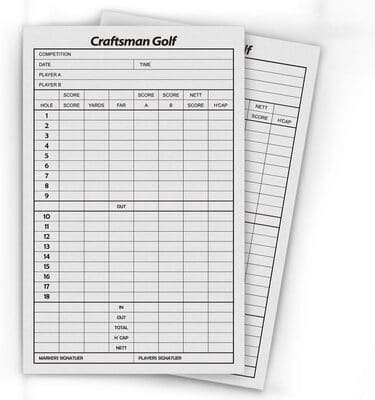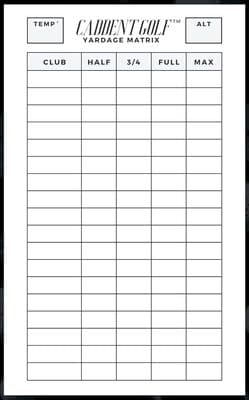Tee it high and let it fly, fellow golfers! The sun is shining, the grass is green, and you’re out on the course. Ready to conquer those fairways and greens. But as you take each swing, you might be wondering, How do you even read a golf scorecard? Don’t worry; we’ve all been there!
Golf is a game of strategy, precision, and patience, but it’s also a game of numbers and stats that can look as complex as a Sudoku puzzle. If you’ve ever found yourself scratching your head, trying to decipher the secrets of the golf scorecard. Then you’re in the right place.
In this blog post, we’re about to unravel the mysteries of the golf scorecard and turn those cryptic notations into a source of golfing wisdom. So, whether you’re a golfing pro looking to brush up on the basics or a newbie who’s still figuring out which end of the club to hold. Join us on this enlightening journey.
Get ready to master the art of decoding those scorecards, from birdies to bogeys and everything in between. We promise it won’t be as daunting as it first appears, and by the end of this post, you’ll be reading golf scorecards like a seasoned pro. So grab your scorecard, a pencil, and that can-do attitude, because we’re about to demystify the world of golf scoring. Let’s dive right in, shall we?
Golf Scorecard Basics
A golf scorecard is a fundamental tool that every golfer utilizes during a round of golf. It serves as a record-keeping device and provides essential information about the golf course. Understanding the format of a golf scorecard and how to read it, is crucial for players to keep track of their scores accurately and strategically plan their game.
A typical golf scorecard contains various sections that provide essential details about the golf course. These sections include the identification of the golf course, the layout of the holes, the yardages, the par ratings, and the handicap ratings. By decoding these sections, golfers can easily navigate through the course and make informed decisions on which clubs to use. And also how to play each hole effectively.
Additionally, the scorecard also offers columns to record scores. Which allows players to keep track of their progress and keep a record of their statistics for future improvement.
Understanding the Format of a Golf Scorecard
The format of a golf scorecard may appear daunting at first glance, but once you understand its components, it becomes a valuable tool for tracking your game and analyzing your performance. It is important to familiarize yourself with the scorecard’s layout and the information it provides. As you can gain a better understanding of the golf course and make more informed decisions during your rounds.
One important aspect of the scorecard is to read the golf course information. This typically includes the name of the course, its location, and its contact details. Recognizing this information is useful when you want to refer to a specific course or share your scorecard with others. Additionally, the scorecard will often provide details about the golf course’s architect and the year it was established. Which can be interesting for golf enthusiasts.

Identifying the Golf Course Information
When trying to read a golf scorecard, one of the first things you’ll notice is the golf course information. This is important because it provides you with key details about the course you’ll be playing on. The information usually includes the name of the golf course, the address, and the contact information. Some scorecards may also include a map or a diagram of the course layout. This can be helpful in familiarizing yourself with the course before you tee off. Additionally, the golf course information will often indicate whether it is a public or private course. As well as any additional amenities or facilities available to golfers.
Another key aspect of identifying the golf course information on a scorecard is determining the course rating and slope rating. The course rating is a number that represents the inherent difficulty of the course for a scratch golfer, while the slope rating is a number that indicates the relative difficulty of the course for a bogey golfer compared to a scratch golfer.
These ratings are important because they give you an idea of the level of challenge you can expect from the course. The course rating and slope rating are typically located near the golf course information. These are crucial factors to consider when planning your game strategy. By understanding these ratings, you can better assess the difficulty of each hole. Allowing you to make informed decisions on how to approach your shots.
Decoding the Holes and Yardages
One of the essential aspects to understand while decoding how to read a golf scorecard is the information related to each hole and its yardage. Yardage refers to the distance from the tee box to the green and encompasses the entire length of the fairway. It serves as a key determinant for club selection and shot strategy. By evaluating the yardages for each hole, golfers can assess the level of difficulty and plan their shots accordingly.
Furthermore, understanding the yardages allows players to anticipate hazards, such as bunkers and water bodies, that may come into play during their round.
In addition to yardage, each hole on a golf scorecard is typically assigned a number, ranging from 1 to 18. This numbering system helps players navigate the course and provides a way to keep track of their progress throughout the round. The numbers also correspond to the stroke index, which indicates the hole’s difficulty relative to par. By carefully examining the holes and their assigned numbers, golfers can strategize their gameplay by targeting specific holes where they may have a better chance of scoring lower.
Overall, decoding the information related to each hole, including its yardage and assigned number, is crucial for golfers seeking to enhance their understanding of the course and improve their scores.
Recognizing the Par and Handicap Ratings
Par and handicap ratings are essential components of a golf scorecard, providing players with crucial information about each hole. The par rating signifies the number of strokes an expert golfer is expected to take to complete a hole. Typically, pars range from three to five strokes per hole, with the majority falling within the par-four category. Understanding the par rating of each hole helps golfers set realistic expectations and plan their game strategy accordingly.
Handicap ratings, on the other hand, level the playing field for players of different skill levels. These ratings indicate the difficulty of a hole relative to a player’s handicap, with the higher the rating, the more challenging the hole is considered. Handicap ratings enable players to determine which holes they may need to approach with caution. As well as which ones might offer opportunities for scoring well. By recognizing both par and handicap ratings on a scorecard, golfers gain valuable insights into the course’s layout and can adjust their gameplay accordingly.
Interpreting Stroke Index and Slope Rating
The stroke index and slope rating are two important factors to consider when interpreting a golf scorecard. The stroke index indicates the difficulty of each hole on the course, ranging from 1 to 18. The lower the stroke index number, the more challenging the hole is expected to be. This information can help golfers strategize their game plan, as they may choose to allocate more practice and focus on the higher stroke index holes.
On the other hand, the slope rating provides an indication of the relative difficulty of a golf course. Especially for players who are not scratch golfers. It takes into account factors such as the course’s length, hazards, and overall design. While stroke index focuses on each hole individually, the slope rating provides an assessment of the course as a whole.
Interpreting the stroke index and slope rating can assist golfers in determining their overall course strategy. By understanding the difficulty level of each hole and the overall challenge of the course, players can make informed decisions on how they approach different shots. Also where they should focus their efforts during practice. Keeping these factors in mind can ultimately lead to better performance and scores on the scorecard.
Analyzing the Scorecard Layout
The layout of a golf scorecard plays a crucial role in helping golfers keep track of their scores and statistics during a round of golf. It typically consists of several components that are organized in a logical and user-friendly manner. One of the key elements found in a scorecard is the course layout diagram. Which provides an overview of the holes and their respective yardages. This diagram allows golfers to visualize the layout of the course and better plan their shots accordingly.
Additionally, the scorecard layout includes the par and handicap ratings for each hole. These are important factors to consider when strategizing your game.
Reading the Scoring Columns
When it comes to how to read the scoring columns on a golf scorecard, there are a few key components that you need to understand. The first column is typically labeled “Hole” or “H,” and it lists the number of each hole on the golf course. This is important for keeping track of your progress throughout the game. The next column, labeled “Par” or “P,” indicates the number of strokes that it should take you to complete each hole based on its difficulty level. It is crucial to pay attention to this column. As it gives you an idea of how well you are performing in comparison to the target score for each hole.
Finally, the third column, usually labeled “Score” or “S,” is where you will record the number of strokes it took you to complete each hole. This column is essential for keeping a tally of your overall score and comparing it to the par score for the course.
Another important element found in the scoring columns is the space to input your handicap strokes. Golfers with a higher handicap typically receive extra strokes on certain holes to even out the playing field. This column, labeled “Handicap” or “HCP,” allows you to determine the number of extra strokes you receive on specific holes. It is essential to take note of your handicap strokes to ensure fair competition and accurately calculate your final score. By understanding and utilizing the various scoring columns on a golf scorecard, you can keep track of your progress, evaluate your game performance, and make strategic decisions to improve your overall score.
Tracking Your Scores and Statistics
Keeping track of your scores and statistics is an essential practice for any golfer looking to improve their game. By monitoring your performance, you can identify areas of weakness and focus on developing specific skills. One of the most commonly tracked statistics is the fairway hit percentage. This measures how many times your tee shot lands on the fairway, indicating the accuracy of your drives. By monitoring this statistic over time, you can identify any patterns or trends that may help you adjust your swing or club selection to improve your accuracy off the tee.
In addition to fairway hit percentage, tracking your greens in regulation (GIR) is another valuable statistic. GIR represents the number of times your approach shot lands on the green in regulation. This means it gives you the opportunity for a one-putt for par. This statistic reflects your ability to control both distance and accuracy with your iron shots. Monitoring your GIR can help you assess the effectiveness of your iron play and identify any areas for improvement. By consistently tracking these statistics, you can gain valuable insights into your game and tailor your practice sessions to address specific weaknesses.

Utilizing the Scorecard for Game Strategy
Utilizing the scorecard for game strategy is an essential aspect of golf that can greatly enhance a player’s chances of success on the course. A well-utilized scorecard can provide valuable insights into a player’s strengths and weaknesses. This allows them to make informed decisions throughout their round. Provided you know how to read your golf scorecard!
One key way to use the scorecard strategically is by analyzing the handicaps and stroke indexes assigned to each hole. These ratings can give players an indication of the difficulty of each hole relative to their own skill level. By taking note of these ratings, golfers can develop a game plan that focuses on capitalizing on easier holes for potential birdies or pars, while exercising caution on more challenging holes that may require more conservative play. This strategic approach can help players optimize their scoring opportunities and minimize unnecessary risks.
Another strategic element that can be derived from the scorecard is the inclusion of hole layouts and yardages. These details provide players with crucial information about the length and layout of each hole, allowing them to devise a game plan that takes into account their own strengths and weaknesses.
For example, a player who excels at long drives may choose to aggressively attack longer holes, aiming for a shorter approach shot to the green.
On the other hand, a player with a strong short game may opt for more conservative tee shots. Focusing on accuracy rather than distance may be the best bet. By analyzing the hole layouts and yardages provided on the scorecard, players can tailor their strategy to their own abilities, maximizing their chances of success.
FAQs
Why is it important to understand the format of a golf scorecard?
Understanding the format of a golf scorecard is important because it provides crucial information about the golf course. Such as hole yardages, par ratings, handicap ratings, stroke index, and slope rating. This information helps golfers make strategic decisions and plan their game accordingly.
How can I identify the golf course information on a scorecard?
Golf course information, such as the name, address, and contact details, is usually located at the top or bottom of the scorecard. It is important to familiarize yourself with this information before starting your game.
What is the significance of decoding the holes and yardages on a scorecard?
Decoding the holes and yardages on a scorecard allows golfers to understand the length and difficulty of each hole. This information helps in club selection and planning shots to optimize performance on the course.
What do the par and handicap ratings on a scorecard indicate?
The par rating on a scorecard indicates the number of strokes a skilled golfer is expected to complete a hole or the entire course in. Handicap ratings, on the other hand, represent the level of difficulty for each hole relative to the player’s skill level. Lower handicap ratings indicate more challenging holes.
What does the stroke index and slope rating on a scorecard mean?
Stroke index refers to the numerical order assigned to each hole, indicating the order in which they should be played based on difficulty. Slope rating, on the other hand, represents the relative difficulty of a course for bogey golfers compared to scratch golfers.
How can I read the golf scorecard layout effectively?
Analyzing the scorecard layout involves understanding the arrangement of holes, yardages, par ratings, handicap ratings, stroke index, and other relevant information. Paying attention to this layout helps golfers plan their game strategy and make informed decisions on each hole.
What should I know about how to read the scoring columns on a golf scorecard?
Reading the scoring columns on a scorecard allows golfers to keep track of their scores for each hole. It typically includes columns for the hole number, par rating, stroke index, and space to record the number of strokes taken. This information helps in monitoring progress and identifying areas for improvement.
How can I effectively track my scores and statistics using a scorecard?
Utilizing the scoring columns on a scorecard helps golfers track their scores for each hole, total score, and statistics. Such as fairways hit, greens in regulation, and number of putts. This data enables golfers to identify strengths and weaknesses in their game and make adjustments accordingly.
How can I utilize the scorecard for game strategy?
The scorecard provides valuable information about the golf course, including hole lengths, difficulty ratings, and stroke index. By analyzing this information, golfers can develop a game strategy that includes club selection, shot planning, and understanding which holes offer the best opportunities for scoring well.



